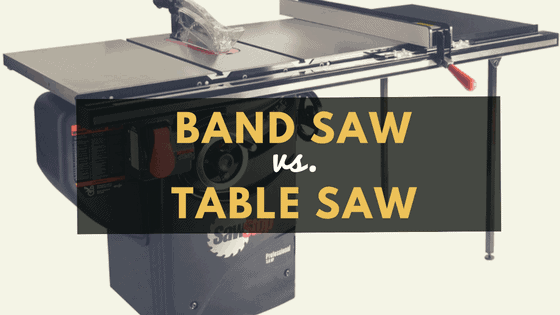Table of contents
Ask The Saw Guy
Talk with Tool Experts & Woodworkers in minutes 24/7
Need Help?
Talk with a tool expert in minutes


Brian, Woodworker
2,153 satisfied customers
Licensed Contractor – 17 years

Brian, Woodworker
2,153 satisfied customers
Message
3 Home Improvement Experts are Online Now
Start Chat
The band saw and the table saw; two very different, yet very commonplace and effective tools that you’ll find in most amateur shops and garages across the globe.
But what’s the difference between the two? What does one do that the other can’t? Do you need both? Which one is more expensive?
These are all questions that we’ll look at in our thorough, ‘what you need to know’ comparison guide between table saws and band saws. Also, like always, towards the end of the article we’ll have a look at a few of our favorite brands and models out there for each particular saw.
Thinking of buying one? Click here for our band saw buying guide and here for our table saw buying guide.
Top Reviewed Table Saws and Band Saws
General overview: Band Saw vs. Table Saw
Generally speaking, the table saw is the more commonplace, more well-rounded, and greater range-of-use saw between the two. It (along with perhaps the circular saw), really is the standard, go-to woodworking power tool; if you’re just starting out setting up a garage or workspace, the table saw should probably be your first purchase, and should be what the rest of the shop is set up around.
That being said, the band saw of course has its specific functions and uses, and rightfully deserves a spot in every complete woodworking garage.
Table Saw
If you’re getting into baseball, you buy a baseball glove. If you’re getting into fishing, you buy a fishing rod. If you’re getting into woodworking, you buy a table saw.
Like we said, it really is the standard woodworking power tool.
Circular saws, miter saws, and routers can all essentially do what a table saw can, but none of them can do everything with the degree of ease, precision, and efficiency of the almighty table saw.
» Complete Review: Best Table Saws
For absolute woodworking beginners, a quality table saw purchase and a good couple hours spent perusing the user manual is all it takes to spawn a fledgling carpenter.
With their adjustable blade depth, different blade types, and fool-proof fence system, table saws are capable of producing precision squares, rips, miters, grooves, bevels, etc. – really anything and everything that you will run into in a rudimentary carpentry voyage.
Band Saw
Like we said, although we would never recommend purchasing a band saw before or in place of a table saw, they certainly can do some things that would be virtually impossible to do on a table saw.
A band saw can do two things that a table saw generally can’t: cut curves (scrolls), and cut really thick pieces of material (3 ½” thick or more).
» Complete Review: Best Band Saws
Band saws can of course be used to make long, straight cuts (rips, squares, etc.) on standard pieces of material like 2×4’s, but because of their narrow, flimsy blade, a table saw is in general a much more effective and practical choice for these kinds of cuts.
Scenarios: When does each saw work best?
-
Rips and squares: If you’re ripping lumber to length and need really straight, long cuts (rips), or if you’re cross-cutting and need perfect squares, the table saw is definitely the proper choice.
-
Grooves, Dados, Insets etc: In instances where you need to cut only part of the way through your material, the table saw is your only option. (Between a table saw and band saw, at least).
-
Miters and bevels: These types of angled cuts can be done with either a band or table saw, but it’ll be much easier to use a table saw, where you simply adjust the blade rather than having to adjust the angle of the material itself.
-
Scroll saws, curves, and other irregular shapes: Obviously, the band saw is your choice here.
Other general things to consider
Before we wrap-up the band saw vs table saw comparison, there’s a few other important things to consider before we let you off to decide which one you need.
Kerf: Kerf is a reference to how much material is actually removed by the saw blade. Because band saws have much, much narrower blades than table saws, they have a smaller kerf and thus remove less material. (This is part of the reason why giant band saws are used at timber mills when raw-ripping full tree trunks – less material is wasted).
Different kinds of material: Different blades can be purchased for table saws that’ll allow you to cut metal, cement board, plastic, etc, but in general band saws are more commonly used for cutting metals and other materials, because the teeth on the blades are much finer and closer together.
Thickness of material: Like we already mentioned, band saws are the better choice if you need to cut through really thick pieces of material. Standard table saws usually have a max blade height of about 3 ½”, so anything thicker than this and you’ll need a band saw.
Safety: First off, no saw should be considered ‘safe’. We’re talking about razor sharp blades spinning at super high rpm’s – there’s nothing safe about that. However, table saws have a general distinction of being one of the more dangerous saws out there, because a lot of times, unless you’re using a push tool (like you always should!), your hands and fingers are super close to the saw blade. Also, table saws are much more prone to sending pieces of material flying away at dangerously high speeds across your garage.
Bottom Line
The bottom line is, if you’re setting up a woodworking shop and you’re trying to decide between a table saw or band saw, for all extensive purposes go with the table saw to start off with.
Now, that’s certainly not saying that band saws are bad, useless, or worse than table saws – they’re just more of a ‘specialty’ saw, and you’ll come across a lot fewer instances around the house where you need a band saw than you do a table saw.

